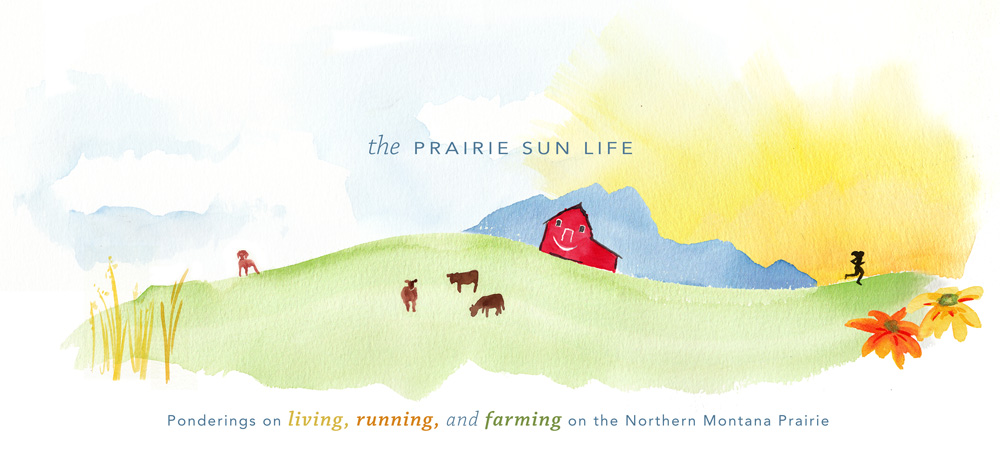Everybody loves a good Before and After photo series, right?
Jeff and I went on a crop tour last night to check on our winter wheat and peas. I remembered as we were walking around that I had gone for a run up to this field last fall and taken a few photos. So, here are the "before" pictures--
 |
| Young winter wheat in the furrows. Planted late last fall. |
 |
| Winter wheat on the right. On the left is a field of spring wheat stubble, which we planted to peas this spring. Also, a red blur in the stubble-- that's my dog, Harvey. :) |
And now the "after" photos. "After" referring to after winter, I guess...
 |
| This is our winter wheat crop now. This was planted on pea stubble. And again, the red-ish blur in the background is my dog. :) |
 |
| Young pea shoots on spring wheat stubble. |
Even though we haven't had any rain this year, our winter wheat is still doing really good. Especially the wheat that was planted on the pea stubble from a few years ago. That field was yellow peas in the summer of 2013, last year it was fallow, and then last fall we seeded winter wheat on that field. If you remember your basic biology, peas are a nitrogen fixer in the soil. Wheat is a nitrogen taker. Jeff attributes the success (so far) of this crop in great part to the nitrogen left by the peas in the soil. We also had significant moisture last fall for planting, which certainly doesn't hurt.
Here is another image of winter wheat, from a field directly across the road to the south of the winter wheat pictured above.
 |
| Winter wheat planted on spring wheat stubble. |
As a reminder for my non-farming friends and family who read the blog, winter wheat is planted in the fall. It must germinate and grow a little, then with hard freeze it dies off for the winter, only to come back up in the spring. It's an interesting crop in that it's life cycle includes two germinations. There are many reasons to include it in our rotation. One is that we have a big enough farm that the time stress to try to plant all of our crops in the spring is great, so planting some winter wheat in the fall helps a lot. Another reason is that winter wheat does typically yield more bushels than spring wheat does, when the right conditions are present. We planted many acres of winter wheat last fall because we had A LOT of moisture in August and September.
This spring, not so much on the moisture front. When I wrote that it hasn't rained this year, that's more or less true. We haven't had any measurable rain of significance in 2015. Last week it rained, but it was a brief shower and we received less than one tenth of an inch of moisture. Better thana kick in the seat, but we all really could have used more. Many farmers, including us, are seeing the effects of drought and disease on their crops. Jeff and I feel pretty lucky that our fields look as good as they do.
Thinking about crop rotation, if our peas never make it to maturity due to lack of moisture, I wonder if they'll still be a good nitrogen source for a future wheat crop? If so, then we may still be money ahead for having planted them, in the long run. Interesting to think about.
Jeff and I spent quite a bit of time yesterday evening discussing our relationship to the farm. Specifically, my relationship to the farm and how my role fits in to the success of the operation. Something like 90% of family farms include at least one person who works off-farm. I guess I fall into that statistic, with my jobs at the school (I work at the school but I am not employed by the school- I work for a separate company). My income, while small (I positively impact children's lives and make less than a person who stocks shelves at Wal-Mart), contributes to the comfortable lifestyle we lead and helps us continue to farm in best way we can. I know there are times when Jeff has wished I had been more available, and my lack of availability can't always be blamed on my job. While I believe it is very important for anyone to take care of themselves and do what they need to do to maintain their own baseline, there are definitely times when I need to be better about balancing my own wants and needs with those of the farm. I guess it's just an ongoing learning process for me to see how exactly to do that. Not so different from balancing nutrients for a crop.


I'm sure you've heard the saying that behind every successful farmer is a wife that works in town :)
ReplyDeleteThe wheat looks good! It was getting a little dry here we have had two good rains so that helped a lot! My Dad plants lentils and peas also. We were trying to decide where the term pulse crop comes in, any idea?
I asked Jeff if he had any idea why they call them pulse crops and he didn't know either... It's a mystery! Calls for more research, to be sure. I've been checking my Instagram and FB all morning to see how your Half is going today!!! I know you're rocking it! :)
Delete